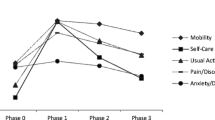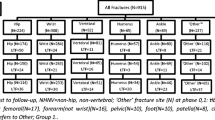Abstract
Summary
We assessed the impact of hip fracture on health-related quality of life (HRQoL) and costs in Estonia. The mean 18-month HRQoL loss in quality adjusted life years (QALY) was estimated at 0.31, and the average cumulative cost from a societal perspective was 8146 euros per hip fracture patient.
Introduction
The aim of this study is to estimate the impact of hip fracture on HRQoL, resource consumption, and cost over 18 months after the fracture among individuals aged over 50 in Estonia.
Methods
A cohort of 205 hip fracture patients ≥50 years was followed up for 18 months. HRQoL was estimated before fracture (recall), after fracture, and at 4, 12, and 18 months using the EQ-5D instrument. Health care utilization and costs were obtained from a public health insurance fund database; social, informal, and indirect costs were estimated using patient-reported data.
Results
Hip fracture resulted in the mean 18-month HRQoL loss of 0.31 QALYs. The mean 18-months cumulative cost of hip fracture from a societal perspective was estimated at 8146 (95 % CI 6236–10717) euros per patient. Most of the cost was related to health care (56 %) and informal care (33 %), while social care contributed only 5 %. Utilization of outpatient rehabilitation and nursing care was low (8 % of patients).
Conclusions
The impact of hip fracture on HRQoL and cost was substantial. Despite appropriate inpatient care, utilization of rehabilitation, nursing care, and social care were low and potentially insufficient to meet the needs of patients with low HRQoL. The shortfall may partially explain a remarkably high use of informal care.


Similar content being viewed by others
References
Melton LJ (2003) Adverse outcomes of osteoporotic fractures in the general population. J Bone Miner Res 18:1139–1141. doi:10.1359/jbmr.2003.18.6.1139
Johnell O, Kanis JA (2006) An estimate of the worldwide prevalence and disability associated with osteoporotic fractures. Osteoporos Int 17:1726–1733. doi:10.1007/s00198-006-0172-4
Johnell O, Kanis JA, Odén A et al (2004) Mortality after osteoporotic fractures. Osteoporos Int 15:38–42. doi:10.1007/s00198-003-1490-4
Johnell O, Kanis JA (2005) Epidemiology of osteoporotic fractures. Osteoporos Int 16(Suppl 2):S3–S7. doi:10.1007/s00198-004-1702-6
Abrahamsen B, van Staa T, Ariely R et al (2009) Excess mortality following hip fracture: a systematic epidemiological review. Osteoporos Int 20:1633–1650. doi:10.1007/s00198-009-0920-3
Hernlund E, Svedbom A, Ivergård M et al (2013) Osteoporosis in the European Union: medical management, epidemiology and economic burden. A report prepared in collaboration with the International Osteoporosis Foundation (IOF) and the European Federation of Pharmaceutical Industry Associations (EFPIA). Arch Osteoporos 8:136. doi:10.1007/s11657-013-0136-1
Borgstrom F, Lekander I, Ivergard M et al (2013) The International Costs and Utilities Related to Osteoporotic Fractures Study (ICUROS)—quality of life during the first 4 months after fracture. Osteoporos Int 24:811–823. doi:10.1007/s00198-012-2240-2
Borgström F, Sobocki P, Ström O, Jönsson B (2007) The societal burden of osteoporosis in Sweden. Bone 40:1602–1609. doi:10.1016/j.bone.2007.02.027
Cheng S, Levy A, Lefaivre K (2011) Geographic trends in incidence of hip fractures: a comprehensive literature review. Osteoporos Int 22:2575–2586. doi:10.1007/s00198-011-1596-z
Odén A, McCloskey EV, Kanis JA et al (2015) Burden of high fracture probability worldwide: secular increases 2010-2040. Osteoporos Int 26:2243–2248. doi:10.1007/s00198-015-3154-6
Ström O, Borgstrom F, Zethraeus N et al (2008) Long-term cost and effect on quality of life of osteoporosis-related fractures in Sweden. Acta Orthop 79:269–280. doi:10.1080/17453670710015094
Borgström F, Zethraeus N, Johnell O et al (2006) Costs and quality of life associated with osteoporosis-related fractures in Sweden. Osteoporos Int 17:637–650. doi:10.1007/s00198-005-0015-8
Rice DP (2000) Cost of illness studies: what is good about them? Inj Prev 6:177–179. doi:10.1136/ip.6.3.177
OECD Data. https://data.oecd.org/. Accessed 8 Jan 2016
(2014) Estonian health insurance fund annual report. https://www.haigekassa.ee/sites/default/files/uuringud_aruanded/haigekassa_aastaraamat_2014_eng.pdf
Jürisson M, Vorobjov S, Kallikorm R et al (2015) The incidence of hip fractures in Estonia, 2005-2012. Osteoporos Int 26:77–84. doi:10.1007/s00198-014-2820-4
EuroQol. http://www.euroqol.org/about-eq-5d.html. Accessed 13 Jul 2015
Estonian Health Insurance Fund. http://www.haigekassa.ee/. Accessed 15 Jul 2015
Dolan P (1997) Modeling valuations for EuroQol health States. Med Care 35:1095–1108
Walters SJ (2009) Quality of life outcomes in clinical trials and health-care evaluation: a practical guide to analysis and interpretation. John Wiley & Sons
Human Mortality Database. http://www.mortality.org/. Accessed 11 Feb 2016
Charlson ME, Pompei P, Ales KL et al (1987) A new method of classifying prognostic comorbidity in longitudinal studies: development and validation. J Chronic Dis 40:373–383. doi:10.1016/0021-9681(87)90171-8
Quan H, Sundararajan V, Halfon P et al (2005) Coding algorithms for defining comorbidities in ICD-9-CM and ICD-10 administrative data. Med Care 43:1130–1139
Quan H, Li B, Couris CM et al (2011) Updating and validating the Charlson comorbidity index and score for risk adjustment in hospital discharge abstracts using data from 6 countries. Am J Epidemiol 173:676–682. doi:10.1093/aje/kwq433
Toson B, Harvey LA, Close JCT (2015) The ICD-10 Charlson Comorbidity Index predicted mortality but not resource utilization following hip fracture. J Clin Epidemiol 68:44–51. doi:10.1016/j.jclinepi.2014.09.017
Tan-Torres Edejer T, Baltussen R, Adam T, et al. (2003) Making choices in health: WHO guide to cost-effectivess analysis.
Ministry of Social Affairs. http://www.sm.ee/en. Accessed 23 Jul 2015
City of Tallinn. http://www.tallinn.ee/eng/. Accessed 23 Jul 2015
Drummond MF (2005) Methods for the economic evaluation of health care programmes. Oxford University Press
Statistics Estonia / Statistikaamet. http://www.stat.ee/. Accessed 5 Feb 2016
World (WHO 2000-2025) Standard - Standard Populations - SEER Datasets. http://seer.cancer.gov/stdpopulations/world.who.html. Accessed 2 Jul 2015
Si L, Winzenberg TM, de Graaff B, Palmer AJ (2014) A systematic review and meta-analysis of utility-based quality of life for osteoporosis-related conditions. Osteoporos Int. doi:10.1007/s00198-014-2636-2
Ström O, Borgström F, Kanis JA et al (2011) Osteoporosis: burden, health care provision and opportunities in the EU: a report prepared in collaboration with the International Osteoporosis Foundation (IOF) and the European Federation of Pharmaceutical Industry Associations (EFPIA). Arch Osteoporos 6:59–155. doi:10.1007/s11657-011-0060-1
Dzajkovska B, Wertheimer AI, Mrhar A (2007) The burden-of-illness study on osteoporosis in the Slovenian female population. Pharm World Sci 29:404–411. doi:10.1007/s11096-007-9091-5
Kudrna K, Krska Z (2005) Expense analysis of the proximal femoral fractures treatment. Rozhl Chir 84:631–634
Stevenson M, Davis S, Kanis J (2006) The hospitalisation costs and out-patient costs of fragility fractures. Women’s Heal Med 3:149–151. doi:10.1383/wohm.2006.3.4.149
Lawrence TM, White CT, Wenn R, Moran CG (2005) The current hospital costs of treating hip fractures. Injury 36:88–91. doi:10.1016/j.injury.2004.06.015, discussion 92
Nurmi I, Narinen A, Lüthje P, Tanninen S (2003) Cost analysis of hip fracture treatment among the elderly for the public health services: a 1-year prospective study in 106 consecutive patients. Arch Orthop Trauma Surg 123:551–554. doi:10.1007/s00402-003-0583-z
Ohsfeldt RL, Borisov NN, Sheer RL (2006) Fragility fracture-related direct medical costs in the first year following a nonvertebral fracture in a managed care setting. Osteoporos Int 17:252–258. doi:10.1007/s00198-005-1993-2
Dimai HP, Redlich K, Peretz M et al (2012) Economic burden of osteoporotic fractures in Austria. Health Econ Rev 2:12. doi:10.1186/2191-1991-2-12
Larg A, Moss JR (2011) Cost-of-illness studies: a guide to critical evaluation. Pharmacoeconomics 29:653–671. doi:10.2165/11588380-000000000-00000
The World Bank Group (2015) The State of health care integration in Estonia
Knies S, Evers SMAA, Candel MJJM et al (2009) Utilities of the EQ-5D: transferable or not? Pharmacoeconomics 27:767–779. doi:10.2165/11314120-000000000-00000
Acknowledgments
ICUROS is a prospective observational study that follows patients for 18 months after a fracture, collecting data on HRQoL, resource utilization, and costs. The study is run under the auspices of the International Osteoporosis Foundation and has enrolled approximately 6000 patients in 11 countries worldwide, including Estonia, since 2007 [7].
The study was supported by the Estonian Science Foundation grant 9368, the Estonian Ministry of Education and Research grant SF0180060s09, the institutional research grants TARTH15017I (Health research in a continuum of the evidence based health practice in Estonia) and IUT 2-8.
Author information
Authors and Affiliations
Corresponding author
Ethics declarations
Informed consent was obtained from all participants, and the study was approved by the Research Ethics Committee of Tartu University.
Conflicts of interest
None.
Rights and permissions
About this article
Cite this article
Jürisson, M., Pisarev, H., Kanis, J. et al. Quality of life, resource use, and costs related to hip fracture in Estonia. Osteoporos Int 27, 2555–2566 (2016). https://doi.org/10.1007/s00198-016-3544-4
Received:
Accepted:
Published:
Issue Date:
DOI: https://doi.org/10.1007/s00198-016-3544-4




